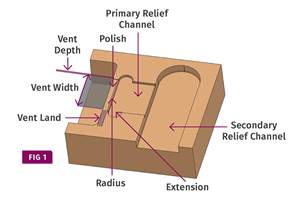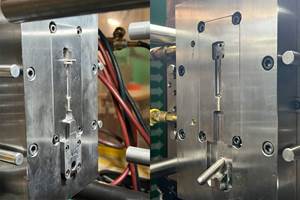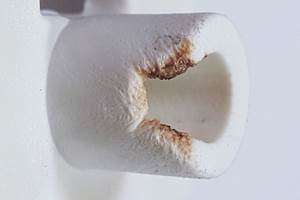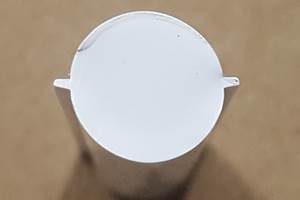Novel Two-Stage Approach Makes Purging Hot Runners a Breeze
Two new and unusual compounds have been developed to ease the challenge of purging injection molding hot-runner systems.
Two new and unusual compounds have been developed to ease the challenge of purging injection molding hot-runner systems. The long residence time of melt in these systems often leads to troublesome deposits of degraded material. These deposits can be hard to dislodge and tend to shed black specks.
One of the new compounds is used at start-up ofa new resin or color. It coats the melt channel, forming a barrier that insulates the resin being molded from excessive heat exposure. It is easy to purge from the system, so it acts more like a release coating for the resin being molded than an actual purging agent.
The other new product is a purging agent that acts by a novel process of “molecular cavitation,” which is said to clean the screw and hot runner safely and more effectively than standard purging materials.
These products are sold under the Cel-Span brand name by Phoenix Plastics, a custom compounder and supplier of specialty additive masterbatches. They were co-developed together with Stabilization Technologies, a consulting firm in Charlotte, N.C, headed by Joseph R. Webster, a well-known expert in additive chemistry for plastics and fibers. According to Webster, such a two-pronged approach provides the best control of black specks and cross-contamination between materials and colors in molded parts.
Both products are typically offered in non-wax polyolefin carriers for resins processed in the 350 to 575 F range, including polyolefins, styrenics, TPOs, TPEs, and TPUs. Custom carriers are offered for other materials, such as glass-filled nylon.
Release coating & heat barrier
Webster describes Cel-Span 310 as an “interfacial resin barrier compound” that is designed for use at start-up to protect the plastic from thermal-oxidative breakdown in hot-runner channels. Containing a proprietary stabilizer system, it functions as a durable release coating that builds up into a heat-stable barrier between the tooling metal and the plastic being molded. Says Webster, “Starting up with 310 after a major hot-runner mold cleanup will establish a thermally stable cap and coat the metal with a heat-stable polymer. It is the key to extended stabilization and prevention of black specks and crossover contamination.”
When it comes time to change colors or resins, Cel-Span 310 is easily expelled with a purging compound, such as Webster’s other new product.
Novel transition purge
Cel-Span 399 transition purging compound functions as both a chemical and physical purging agent in hot-runner systems with frequent resin or color changes. It contains a proprietary inorganic, non-abrasive, nitrogen-based chemical foaming agent. It is non-acidic and non-corrosive and produces no acidic byproducts that can interact with the mold or materials being molded. As with other chemical purging agents, it also contains detergents and a thermal-oxidative stabilizer system.
Although initiated by chemical foaming, the compound’s physical purging action is accomplished by microscopic gas bubbles. The bubbles expand and condense into a liquid that solvates and softens de-graded resins and remnants of the previous color or material. In what Webster calls molecular cavitation, the bubbles expand and contract and work their way under degraded material that has adhered to the screw and/or hot runner.
“When the cavitation is at its best, the cycle of gas to liquid to gas is resonant and acts to remove by solvation all remnants of the material on the screw and hot-runner wall. This physical purging action, in combination with the chemical action of the other ingredients, prevents viscosity drop while maintaining the oxidative integrity of the plastic over time,” says Webster.
Related Content
Back to Basics on Mold Venting (Part 2: Shape, Dimensions, Details)
Here’s how to get the most out of your stationary mold vents.
Read More3D Printing of Injection Molds Flows in a New Direction
Hybrids of additive manufacturing and CNC machining can shorten tooling turnaround times.
Read MoreBack to Basics on Mold Venting (Part 1)
Here’s what you need to know to improve the quality of your parts and to protect your molds.
Read MoreWhere and How to Vent Injection Molds: Part 3
Questioning several “rules of thumb” about venting injection molds.
Read MoreRead Next
How Polymer Melts in Single-Screw Extruders
Understanding how polymer melts in a single-screw extruder could help you optimize your screw design to eliminate defect-causing solid polymer fragments.
Read MoreProcessor Turns to AI to Help Keep Machines Humming
At captive processor McConkey, a new generation of artificial intelligence models, highlighted by ChatGPT, is helping it wade through the shortage of skilled labor and keep its production lines churning out good parts.
Read MoreAdvanced Recycling: Beyond Pyrolysis
Consumer-product brand owners increasingly see advanced chemical recycling as a necessary complement to mechanical recycling if they are to meet ambitious goals for a circular economy in the next decade. Dozens of technology providers are developing new technologies to overcome the limitations of existing pyrolysis methods and to commercialize various alternative approaches to chemical recycling of plastics.
Read More










.png;maxWidth=300;quality=90)















.png;maxWidth=970;quality=90)